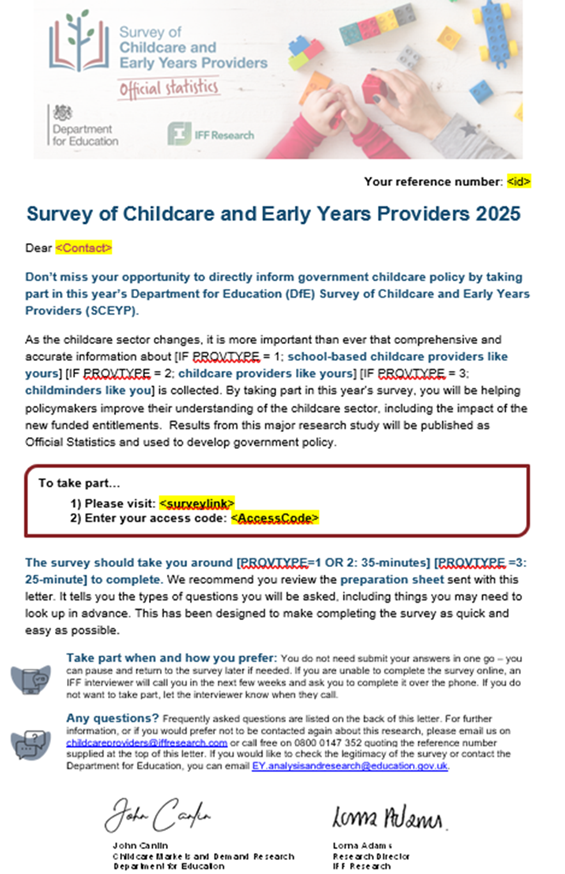The Survey of Childcare and Early Years Providers (SCEYP) is important for monitoring and evaluating childcare and early years provision. It covers childminders, school-based childcare providers (both maintained nursery schools and other schools offering nursery classes) and group-based childcare providers (other childcare providers operating on non-domestic premises, such as playgroups and day nurseries). It helps the Government, including the Department for Education (DfE), understand the issues that providers face, informing development of early years and childcare policy.
The survey has been running since 1998, with the latest 2025 iteration carried out by IFF Research and London Economics. The SCEYP comprises a large mixed-mode survey, which can be completed either online or over the telephone. Topics covered include the number of children registered at different settings, attendance and capacity, staff-to-child ratios, Government funding for childcare including funded entitlements and Tax-free Childcare (TFC), Special Educational Needs and Disabilities (SEND), staff qualifications and pay, and the financial side of providing childcare such as costs, incomes and fees.
1.1 The SCEYP timeseries
The SCEYP has undergone some changes in scope and design over time, which mean comparisons between different survey years should be approached with caution:
- The questionnaire was fully redesigned in 2016 to reflect changes in the childcare market. Data from the 2016 survey were intended to provide a new and enhanced baseline. Changes made to the design of the survey that year mean that 2016 data are not directly comparable with those from previous years of the survey. There were some further changes to the 2018 survey to improve data quality and to reflect new policy priorities, but otherwise it was designed to be comparable with the 2016 survey.
- From 2019 – and following a user consultation on the frequency, sampling approach, mode and topic coverage of the SCEYP[1] – DfE decided to intensify the early years focus of the survey by only sampling and recruiting providers delivering childcare to pre-school children aged 0-4 years. Previous surveys had covered reception provision as well as wraparound and holiday care for school-aged children aged up to seven. This means that figures published before and after 2019 are not comparable for “all school-based providers” and “all providers”. Adjustments have been made, however, to figures collected on surveys prior to 2019 to ensure that where these are shown in reports published since 2019 they are comparable with the most recent data.
- In more recent years, following consultation with DfE and through cognitive testing with providers, further refinements have been made to some of the survey questions. Such changes have been made with a view to improving respondent experience as well as collecting more reliable data. They include:
- In 2023 the cost and income element of the survey was re-designed to make answering these questions easier.
- In 2024, various clarifications and validation checks were added to questions about the number of booked places at providers, number of paid staff employed, and staff salaries and contracted hours of work.
- In 2025, a ‘short’ version of the survey (asking providers about the fees that they charged to parents and funding rates they received from their local authorities) was dropped and all providers were sent the bigger, ‘main’ survey, in order to maximise the number of responses that this received.
[1] Department for Education (2018): Surveys on childcare and early years in England: Government consultation response (opens in new tab)
1.2 Temporary closed settings
Fieldwork for the 2025 survey took place between May and July 2025. To try to obtain as accurate a picture as possible of available childcare provision in 2025, providers were invited to complete the survey if they had been open and offering relevant childcare in the last 30 days, even if their setting was temporarily closed at the time of interview. Settings that were open were asked to think about their current situation, whilst settings temporarily closed at the time of interview were asked to answer with reference to the last term-time day on which they were open.
Of the 9,358 respondents who completed the survey, 11 answered that they had temporarily closed less than 30 days prior to interview. 181 providers we contacted had been closed for more than 30 days. These providers were screened out prior to fieldwork commencing.

